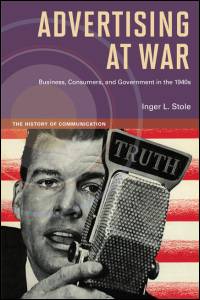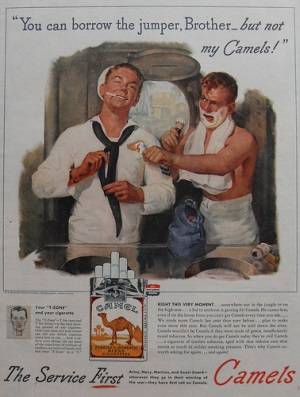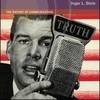 Advertising at War is a book by Inger L. Stole published last year by the University of Illinois Press. In it, Stole, an associate professor of communications at UI, looks at the advertising industry in the United States from the late 1930s through World War II and into the early years of the Cold War. The book shows how the advertising industry improved both its relationship with the government and its own public image during this period.
Advertising at War is a book by Inger L. Stole published last year by the University of Illinois Press. In it, Stole, an associate professor of communications at UI, looks at the advertising industry in the United States from the late 1930s through World War II and into the early years of the Cold War. The book shows how the advertising industry improved both its relationship with the government and its own public image during this period.
Advertising at War is well researched, clearly written, and is useful for understanding how advertising has come to have such a prominent role in American society today. Stole responded to my questions about her book by email.
Smile Politely: You mention the desire of the 1930s consumer movement to have the government mandate some kind of ranking or grading system as a means of comparison between similar products. However, most manufacturers “did not want the properties of their trademark to be known out of fear that consumers would discover that heavy advertising did not guarantee high quality,” and such a grade labeling system was not established.
If one had been, in your opinion, would the advertising industry have lost some of its power at the time, or would things have continued pretty much in the same vein anyway?
Inger L. Stole: There really is no way of knowing this, but a grading system would at least have given consumers a fair chance, allowing them to balance advertising hyperbole with more factual information. In theory, it might have encouraged business to concentrate on producing products more efficiently and selling them for lower prices than on creating artificial distinctions that had no bearing on the actual product. We do not, however, know how many consumers might have taken advantage of this information (if available) and how many might have ignored it in favor of relying on ads as usual. Quite possibly, the grading system might have been of great (er) interest in times when consumers needed to make wise choices to save money or, as during WWII, making sure they got the best deal possible for their rationing points. Not wanting to take any risks, the advertising industry proceeded as I discuss in the book.
 SP: You document the silliness and trivial quality to much of the war-themed advertising in the United States during the war years relative to the serious and deadly consequences of actual combat. I’m thinking in particular of the advertisement for Camel cigarettes reprinted in your book, where a comic book soldier cheerfully races around in his giant tank while craving a Camel. Was advertising in Great Britain – where civilian consumers were seeing more actual violence than in the United States – during the war years more realistic in how it dealt with warfare?
SP: You document the silliness and trivial quality to much of the war-themed advertising in the United States during the war years relative to the serious and deadly consequences of actual combat. I’m thinking in particular of the advertisement for Camel cigarettes reprinted in your book, where a comic book soldier cheerfully races around in his giant tank while craving a Camel. Was advertising in Great Britain – where civilian consumers were seeing more actual violence than in the United States – during the war years more realistic in how it dealt with warfare?
Stole: Good question, but I do not know the answer. For this book, I limited my research to WWII advertising in the U.S.
SP: In Chapter Four of your book, you write of the conflict between advertising and the consumer advocates who worried about its influence, “As powerful as the advertising industry was as a lobbying force, the consumer movement was weak and ineffectual, even inept.”
It’s interesting to consider that the advertising industry in trying to make itself look good, was basically doing what it was designed to do: sell something, in this case its own public image.
In your opinion, is there anything the consumer movement could have done differently that would have helped its cause during the 1940s, or was the advertising industry just too powerful and organized a foe?
Stole: By the late 1930s, and after the passage of the Wheeler-Lea Amendment, the consumer movement included a wide range of groups with consumer protection on their agenda. Some, including Consumers Union, continued to view advertising as a deterrent to marketplace fairness while other groups sought cooperation with advertisers (forcing them to become more honest and responsible to consumer needs) as their strategy. This “fracturing” of the movement became even more evident during WWII. Many consumer activists devoted themselves to helping fellow citizens adjust to a war economy by pledged time and efforts to programs (both governmental and non-profits) that educated consumers about product shortages, substitutes, and rationing.
Also, considering the much larger conflict brought on by war, there seemed to be less interest in confronting business and continuing the fight against commercial forces. In this environment, Warne’s astute observations and appropriate warnings failed to gain much momentum. In retrospect, and especially in light of how the advertising industry refused to take a break from its agenda, one could wish the consumer movement had been more aggressive, but hindsight, as we know, is always 20/20. So to (finally) answer the question, the advertising industry’s victory was clearly due to it being better organized, but the consumer movement’s inability/unwillingness to collectively continue the fight might also have played a role in the advertising industry’s success.
SP: You mention that in the 1940s it was crucial to the commercial press that the advertising industry prosper, since advertising revenue kept magazines and newspapers in business. Today, when anyone can print anything on the Internet without necessarily selling advertising space to do so, has the advertising industry lost any of its power?
Stole: While it is true that anyone can write whatever they want and post it on the Internet, it doesn’t necessarily mean that it will be accessible and, thus, read. In order to attract readers to a website, the site needs interesting, updated content and this costs money. Unless the website is run by independently wealthy individuals with money to burn, revenue has to be generated. Although the pay-for-content model has been tried (and some websites use it for access to select stories), most Internet users reject this. Thus, a website’s chance of survival is hinged to its ability to attract advertising.
Thus, advertising’s power over new media is just as strong (if not stronger) than over the old (print/broadcasting) versions. Also, the Internet has dramatically changed advertising strategies. Consumers’ exposure to advertising is no longer limited to ads and commercials. The Internet allows for constant targeting of consumers (based on their individual online activities). Websites and social networks (Facebook) harvest information about their users and sell this data to interested parties (including advertisers), who then tailor their ads to the individual based on the demographic information provided. For example, if you and I enter the same (commercial) website at the same time, we’ll see very different ads based on our past Internet activities. Thus, I will argue that the Internet has made advertising more insidious and that it holds the power to influence us even more than back when print and TV/radio ads were the only dispensers of commercial messages.
SP: In the last paragraph of your book, you write, “It is through an appreciation of the social, economic and political forces that have established advertising as a seeming inviolable American institution that we can gain the necessary guidance for a new public debate on what has become, for better or for worse, a defining aspect of America.”
In your opinion, is it more for the better or more for the worse that advertising has become as important in American society as it has?
Stole: I view advertising (and the values it promotes) as having a problematic effect on American society. Commercial values play a large role in most aspects of modern society, and our endless quest for new consumer goods and gadgets have, in spite [of] advertised promises, failed to make us happier as individuals.








